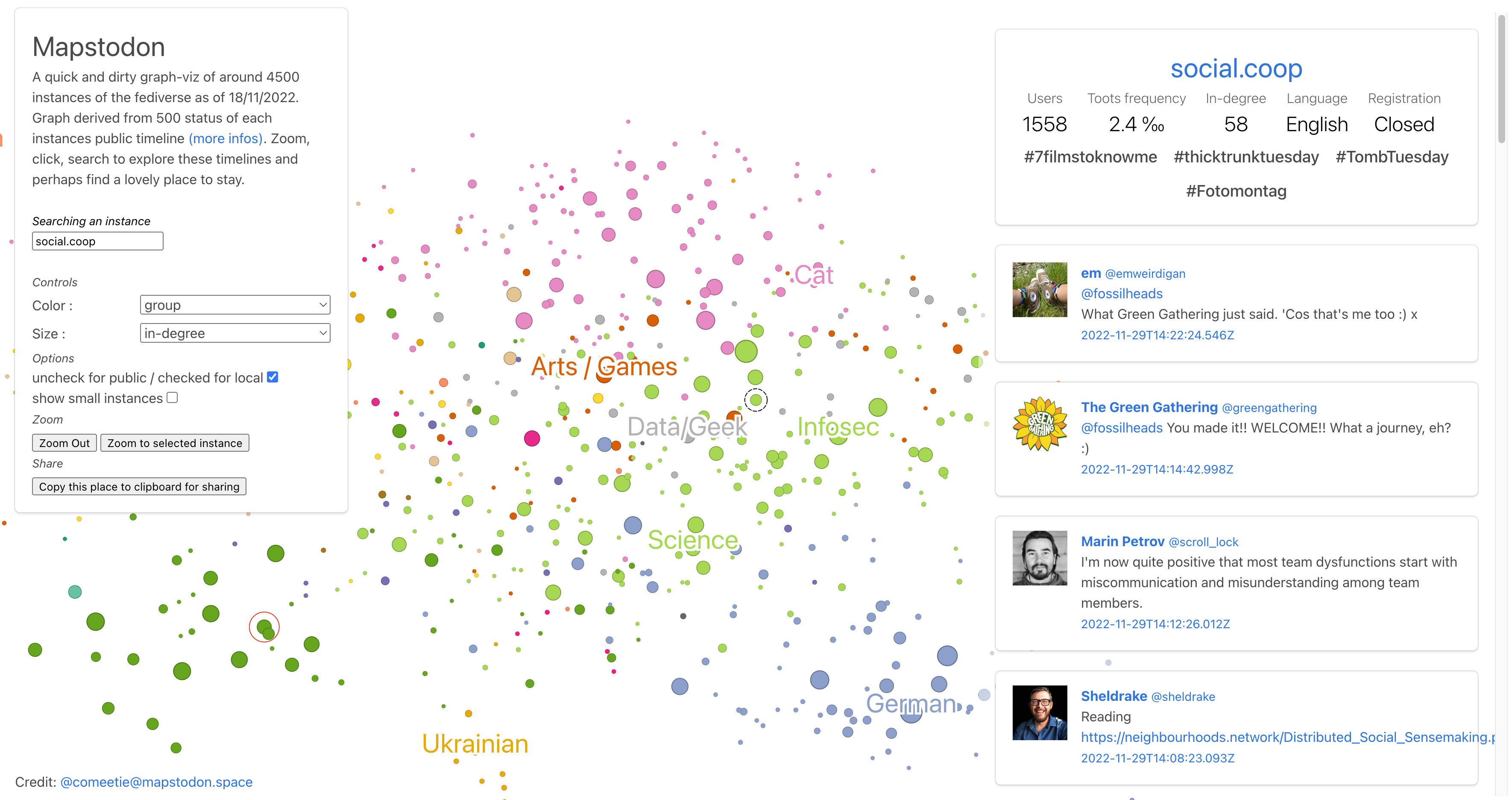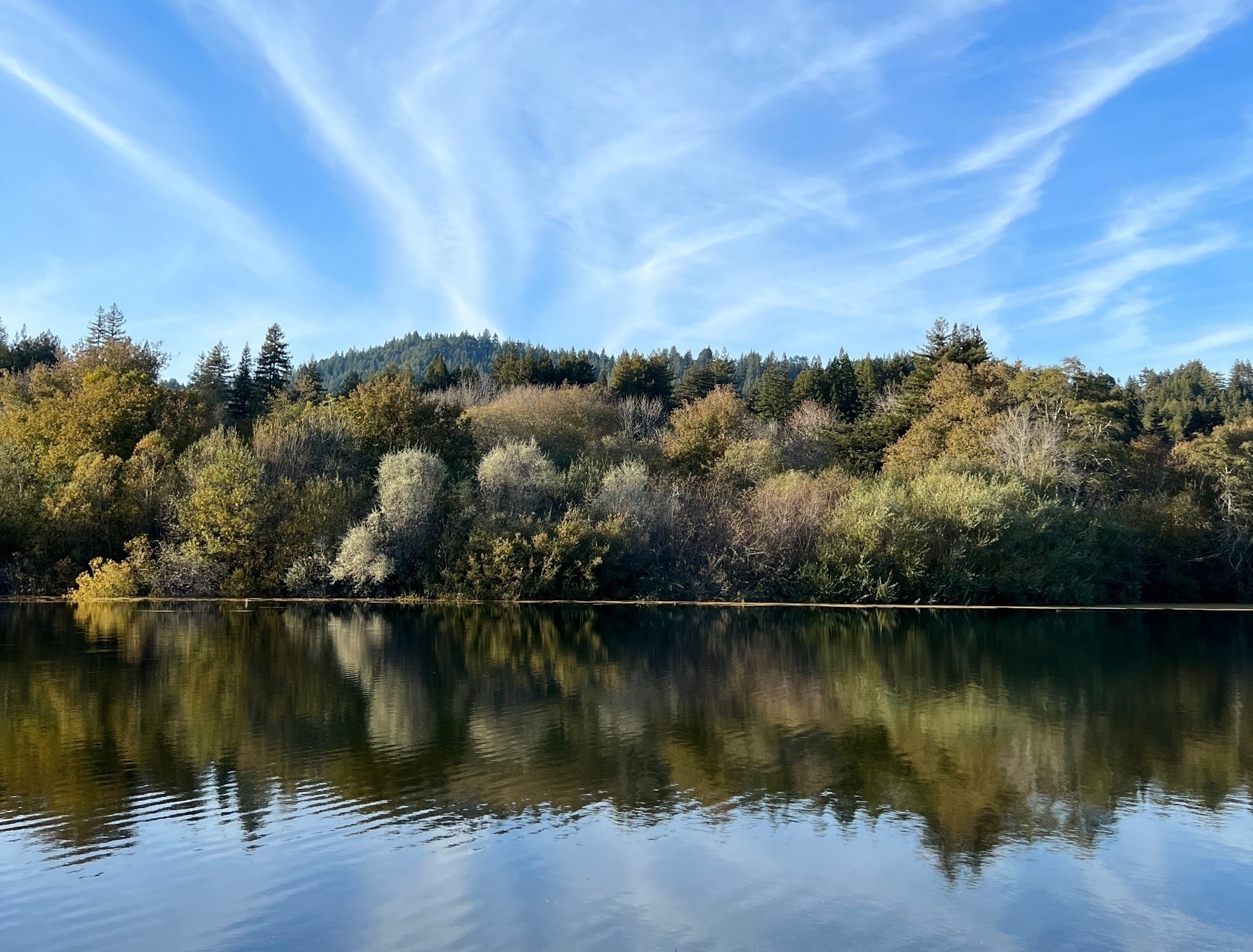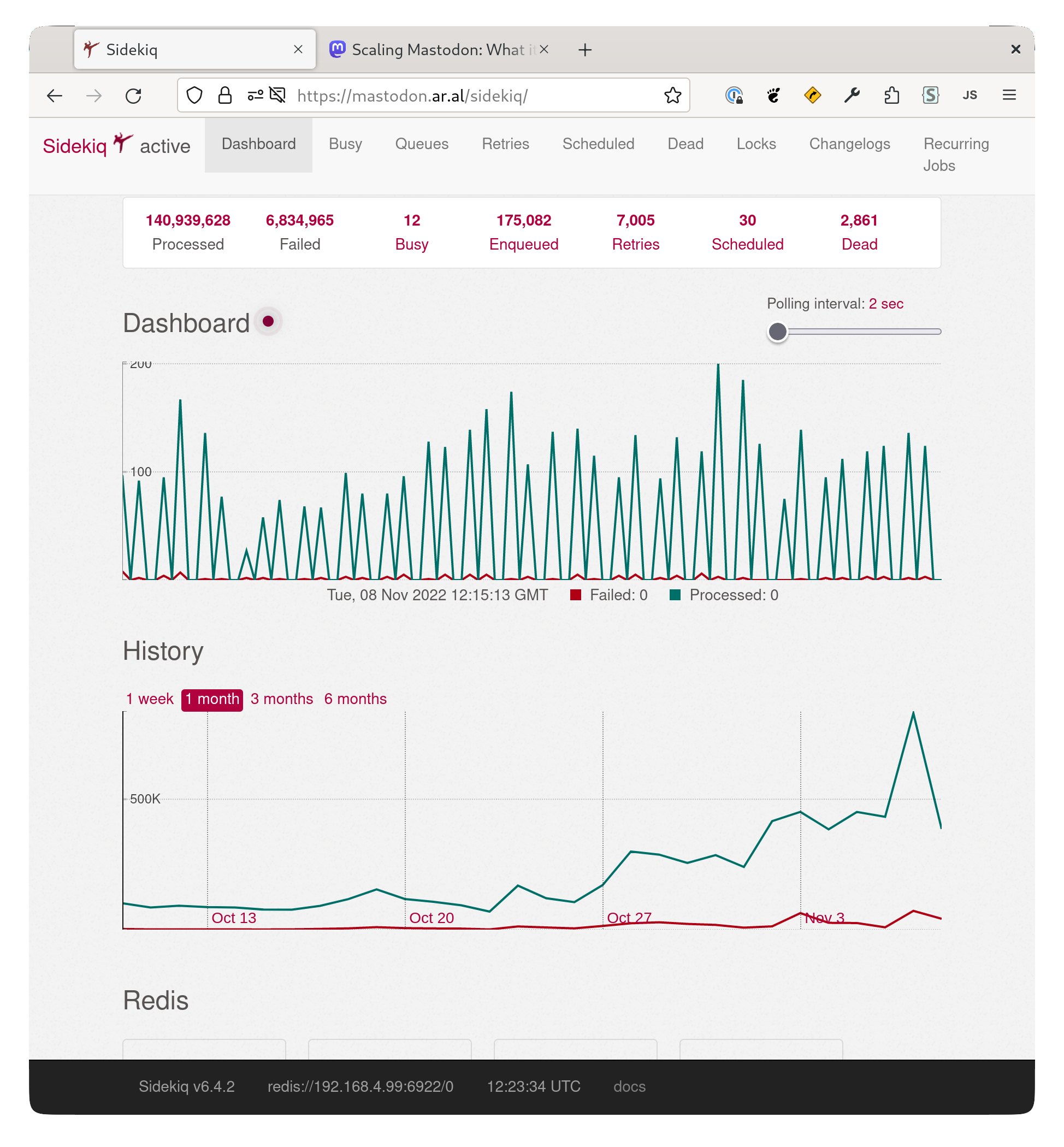- Britain tamed Big Tech and nobody noticed (WIRED)
- Twitter Arguments (OneZero)
- I wish the fediverse had ‘circles’ (Ru Singh)
(Partially) visualising the Fediverse
About a decade ago, it was possible to visualise your LinkedIn network. I really liked it, especially as I had three distinct groups of connections (EdTech, schools, and Higher Ed).
This website allows you to visualise around 4.5k Fediverse instances, as of last week. You can change the colour and size of the dots depending on number of users, posts, theme, etc.
Exercise.cafe isn’t on there, nor is wao.wtf. But it’s still a useful tool.
Source: Mapstodon
Collectively-owned Fediverse instances
I’m essentially bookmarking this publicly as it’s a useful reference for Fediverse instances (all currently running Mastodon!) which are collectively owned.
What I’m interested in is diversifying and going beyond this very useful list. First, I’d love examples to be added which are running other Fediverse software than Mastodon. For example, I’ve got a test instance of Misskey running at wao.wtf.
Second, I’m interested in the governance of these instances. If you’re not involved with co-operatives or other organisations that are democratically operated, it can seem like a bit of a black box. So I think we need a collaboratively-created guide to collective decision-making processes when it comes to Fediverse instances.
Fediverse instances with an explicit system of shared governance, usually made legally binding through an incorporated association or cooperative.Source: Collectively owned instances - fediparty | Codeberg.orgThis page will list also instances which are closed for registrations and dead instances, so that we can collectively learn from their experience.
Originally created by @nemobis@mamot.fr inspired by a @Matt_Noyes@social.coop thread.
Decentralisation begins at decentring yourself
Aral Balkan, who has 22,000 followers on the Fediverse and who recently had a birthday, has written about the influx of people from Twitter. As I’ve found, especially on my personal blog, you can essentially run a Distributed Denial of Service (DDoS) attack on yourself by posting a link to your blog to the Fediverse. As each server pings it, the server can eventually buckle under the weight.
What follows is a really useful post in terms of Aral’s journey towards what he calls the ‘Small Web’. While I don’t necessarily agree that we should all have our own instances, I do think it’s useful for organisations of every size to run them.
If Elon Musk wanted to destroy mastodon.social, the flagship Mastodon instance, all he’d have to do is join it.Thank goodness Elon isn’t that smart.
I jest, of course… Eugen would likely ban his account the moment he saw it. But it does illustrate a problem: Elon’s easy to ban. Stephen, not so much. He’s a national treasure for goodness’ sake. One does not simply ban Stephen Fry.
And yet Stephen can similarly (yet unwittingly) cause untold expense to the folks running Mastodon instances just by joining one.
The solution, for Stephen at least, is simple: he should run his own personal instance.
(Or get someone else to run it for him, like I do.)
Running his own instance would also give Stephen one additional benefit: he’d automatically get verified.
After all, if you’re talking to, say, @stephen@social.stephenfry.com, you can be sure it’s really him because you know he owns the domain.
Organisations are not just joining the Fediverse, they're setting up their own instances
It’s great to see that Raspberry Pi Ltd. and other organisations are setting up their own servers. Not only does it enable them to verify themselves, but that of their employees and affiliates really easily.
I’m sure it won’t all be smooth sailing ahead for the Fediverse, especially when it comes to trust and verification. But I’m optimistic that the recent migration from Twitter is ultimately for the good of the human species.
We’ve opted to host our own instance. We’ve done this because, with multiple instances out there, we had to decide how to make sure people following us knew that our Raspberry Pi account was the “real” one.Source: An escape pod was jettisoned during the fighting | Raspberry PiDistributed systems are an interesting corner case when it comes to trust. Because when it comes to identity, you eventually have to trust someone. Whether that’s a corporation, like Twitter, or a government, or the person themselves. Trust is needed.
With Mastodon the root of trust for identity is the admin of the instance you’re on, and the admins on all the other instances, where you’re trusting them to remove “fake” accounts. Or, if you’re running your own instance, then it’s the domain name registrars. The details of our domain registration of the
raspberrypi.socialdomain may be redacted for privacy, but our domain registrar knows who we are, and is the same registrar we use for all our other domains. They trust our government-issued identity to prove that we are Raspberry Pi Ltd. You can trust them, they trust the government, and ultimately the government trusts us because they can use Ultima Ratio Regum, the last argument of kings.
Decentralising online learning
A “technical presentation that is structured and designed for a non-technical audience” by Stephen Downes. With the Twitter lifeboats again being deployed, this is a timely look at how federated and decentralised technologies can be used for removing the silos from online learning.
Source: Open Learning in the Fediverse | Stephen DownesAs a new generation of digital technologies evolves we are awash in new terms and concepts: the metaverse, the fediverse, blockchain, web3, acitivitypub, and more. This presentation untangles these concepts and presents them from the perspective of their impact on open learning.
Every complex problem has a solution which is simple, direct, plausible — and wrong
This is a great article by Michał Woźniak (@rysiek) which cogently argues that the problem with misinformation and disinformation does not come through heavy-handed legislation, or even fact-checking, but rather through decentralisation of funding, technology, and power.
I really should have spoken with him when I was working on the Bonfire Zappa report.
While it is possible to define misinformation and disinformation, any such definition necessarily relies on things that are not easy (or possible) to quickly verify: a news item’s relation to truth, and its authors’ or distributors’ intent.Source: Fighting Disinformation: We’re Solving The Wrong Problems / Tactical Media RoomThis is especially valid within any domain that deals with complex knowledge that is highly nuanced, especially when stakes are high and emotions heat up. Public debate around COVID-19 is a chilling example. Regardless of how much “own research” anyone has done, for those without an advanced medical and scientific background it eventually boiled down to the question of “who do you trust”. Some trusted medical professionals, some didn’t (and still don’t).
[…]
Disinformation peddlers are not just trying to push specific narratives. The broader aim is to discredit the very idea that there can at all exist any reliable, trustworthy information source. After all, if nothing is trustworthy, the disinformation peddlers themselves are as trustworthy as it gets. The target is trust itself.
[…]
I believe that we are looking for solutions to the wrong aspects of the problem. Instead of trying to legislate misinformation and disinformation away, we should instead be looking closely at how is it possible that it spreads so fast (and who benefits from this). We should be finding ways to fix the media funding crisis; and we should be making sure that future generations receive the mental tools that would allow them to cut through biases, hoaxes, rhetorical tricks, and logical fallacies weaponized to wage information wars.
Every complex problem has a solution which is simple, direct, plausible — and wrong
This is a great article by Michał Woźniak (@rysiek) which cogently argues that the problem with misinformation and disinformation does not come through heavy-handed legislation, or even fact-checking, but rather through decentralisation of funding, technology, and power.
I really should have spoken with him when I was working on the Bonfire Zappa report.
While it is possible to define misinformation and disinformation, any such definition necessarily relies on things that are not easy (or possible) to quickly verify: a news item’s relation to truth, and its authors’ or distributors’ intent.Source: Fighting Disinformation: We’re Solving The Wrong Problems / Tactical Media RoomThis is especially valid within any domain that deals with complex knowledge that is highly nuanced, especially when stakes are high and emotions heat up. Public debate around COVID-19 is a chilling example. Regardless of how much “own research” anyone has done, for those without an advanced medical and scientific background it eventually boiled down to the question of “who do you trust”. Some trusted medical professionals, some didn’t (and still don’t).
[…]
Disinformation peddlers are not just trying to push specific narratives. The broader aim is to discredit the very idea that there can at all exist any reliable, trustworthy information source. After all, if nothing is trustworthy, the disinformation peddlers themselves are as trustworthy as it gets. The target is trust itself.
[…]
I believe that we are looking for solutions to the wrong aspects of the problem. Instead of trying to legislate misinformation and disinformation away, we should instead be looking closely at how is it possible that it spreads so fast (and who benefits from this). We should be finding ways to fix the media funding crisis; and we should be making sure that future generations receive the mental tools that would allow them to cut through biases, hoaxes, rhetorical tricks, and logical fallacies weaponized to wage information wars.
Microcast #091 — Arguing in circles
Overview
An eclectic mix of articles in today's microcast, covering everything from teens and tech to Fediverse functionality.
Show notes
Image via Pexels
Background music: Shimmers by Synth Soundscapes (aka Mentat)
Saturday sailings
I deactivated my Twitter account this week. I've done that before, but this time I'm honestly not sure if I'll reactivate it.
Given that I get a fair few links through Twitter, I wonder if the kind of things I share in these weekly link roundups will change? We shall see, I guess. You can connect with me via the Fediverse: https://mastodon.social/@dajbelshaw
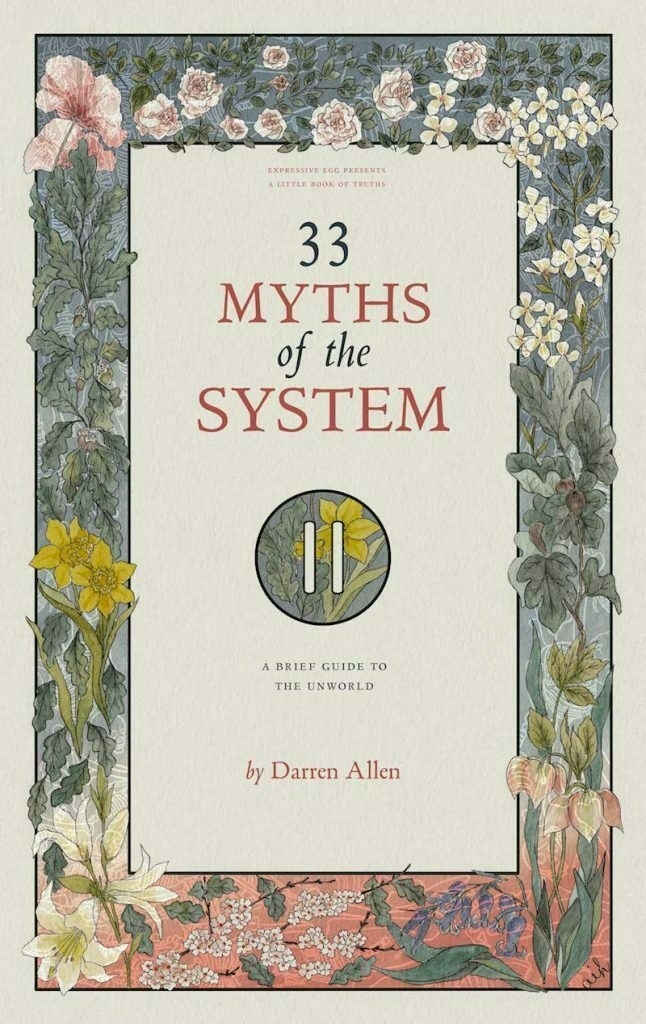
33 Myths of the System
Drawing on the entire history of radical thought, while seeking to plumb their common depths, 33 Myths of the System, presents a synthesis of independent criticism, a straightforward exposure of the justifications of the world-system, along with a new way to perceive and understand the unhappy supermind that directs, penetrates and even lives our lives.
Darren Allen
While I didn't agree with absolutely everything in this free e-book, it's fair to say it blew my mind. Highly recommended, especially for thoughtful people. One of the best things I've read in the last decade in terms of getting me to question... everything.
A catastrophe at Twitter
In any case, Twitter’s response to the incident offered further cause for distress. The company’s initial tweet on the subject said almost nothing, and two hours later it had followed only to say what many users were forced to discover for themselves: that Twitter had disabled the ability of many verified users to tweet or reset their passwords while it worked to resolve the hack’s underlying cause.
The near-silencing of politicians, celebrities, and the national press corps led to much merriment on the service — see this, along with Those good tweets below, for some fun — but the move had other, darker implications. Twitter is, for better and worse, one of the world’s most important communications systems, and among its users are accounts linked to emergency medical services. The National Weather Service in Lincoln, IL, for example, had just tweeted a tornado warning before suddenly going dark. To the extent that anyone was relying on that account for further information about those tornadoes, they were out of luck.
Casey Newton (The INterface)
I didn't actually deactivate my Twitter account because of the hack — that was actually more to do with the book mentioned above — but as a verified user, this certainly reinforced my decision. Just a reminder that at least one person with nuclear codes uses Twitter as their primary means of communication.
This is Fine: Optimism & Emergency in the P2P Network
Centralised platforms crave data collection and thirst for trust from the communities they seek to exploit. These platforms sell bloated, overpowered hardware that cannot be repaired, vulnerable to drops in consumer spending or spasms in the supply chain. They anxiously eye legislation to compel encryption backdoors, which will further weaken the trust they need so badly. They wobble beneath network disruptions (such as the worldwide slowdowns in March under COVID-19 load surges) that incapacitate cloud-dependent devices. They sleep with one eye open in countries where authoritarian governments compel them or their employees to operate as an informal arm of enforcement. These current trajectories point to the accelerating erosion of centralised platform power.
Cade Diehm (The New Design Congress)
This is an incredible article that's very well presented. I keep talking about the importance of decentralisation, and this article backs that up — but also explains how and why decentralised social networks need to do better.

Our remote work future is going to suck
While the upsides to remote work are true, for many people remote work is a poison pill — one where you are given “control” in the name of productivity in exchange for some pretty nasty long-term effects.
In reality, remote work makes you vulnerable to outsourcing, reduces your job to a metric, creates frustrating change-averse bureaucracies, and stifles your career growth. The lack of scrutiny our remote future faces is going to result in frustrated workers and ineffective companies.
Sean Blanda
I'm a proponent of remote work, but I was nodding along to many of the points made in this post. Context is everything, and there's something to be said about being able to go home to escape work.
CO2 emissions on the web
Your content site probably doesn’t need JavaScript. You probably don’t need a CSS framework. You probably don’t need a custom font. Use responsive images. Extend your HTTP cache lifetimes. Use a static site generator or wp2static.com instead of dynamically generating each page on the fly, despite never changing. Consider ditching that third-party analytics service that you never look at anyway, especially if they also happen to sell ads. Run your website through websitecarbon.com. Choose a green web host.
Danny van Kooten
This week I changed the theme over at my personal blog to one that is much lighter. When I shared what I'd done on Mastodon, someone commented that they didn't think it would make that much difference. This post was written by someone who popped up to rebut what they said.
Ask a Sane Person: Jia Tolentino on Practicing the Discipline of Hope
INTERVIEW: What has this pandemic confirmed or reinforced about your view of society?
TOLENTINO: That capitalist individualism has turned into a death cult; that the internet is a weak substitute for physical presence; that this country criminally undervalues its most important people and its most important forms of labor; that we’re incentivized through online mechanisms to value the representation of something (like justice) over the thing itself; that most of us hold more unknown potential, more negative capability, than we’re accustomed to accessing; that the material conditions of life in America are constructed and maintained by those best set up to exploit them; and that the way we live is not inevitable at all.
Christopher Bollen
I have to confess to not knowing who Jia Tolentino was before stumbling across this via the Hurry Slowly newsletter (although I must have read her writing before). This is a fantastic interview, which you should read in its entirety.
Header image by Fab Lentz
Saturday scrapings
Every week, I go back through the links I've saved, pick out the best ones, and share them here. This week is perhaps even more eclectic than usual. Enjoy!
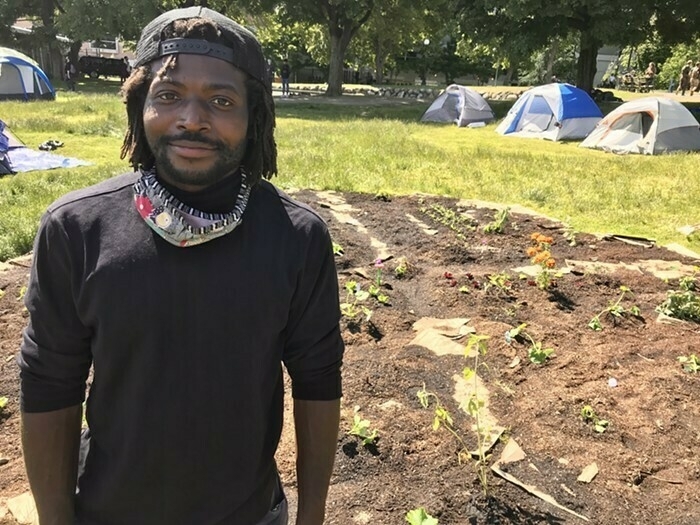
Meet the Farmer Behind CHAZ's Vegetable Gardens
Marcus was the first to start gardening in the park, though he was quickly joined by friends and strangers. This isn’t the work of a casual amateur; Henderson has an Energy Resources Engineering degree from Stanford University, a Master’s degree in Sustainability in the Urban Environment, and years of experience working in sustainable agriculture. His Instagram shows him hard at work on various construction and gardening projects, and he’s done community development at organic farms around the world.
Matt Baume (The Stranger)
I love this short article about Marcus Henderson, the first person to start planting in Seattle's Capitol Hill Autonomous Zone.
The Rich Are 'Defunding' Our Democracy
“Apparently,” comments [journalist David] Sirota, “we’re expected to be horrified by proposals to reduce funding for the militarized police forces that are violently attacking peaceful protesters — but we’re supposed to obediently accept the defunding of the police forces responsible for protecting the population from the wealthy and powerful.”
Sam Pizzigati (Inequality.org)
A lot of people have been shocked by the calls to 'defund the police' on the back of the Black Lives Matter protests. The situation is undoubtedly worse in the US, but I particularly liked this explainer image, that I came across via Mastodon:

Peasants' Revolt
Yet perhaps the most surprising feature of the revolt is that in-spite of the modern title, Peasants' Revolt didn't gain usage until the late nineteenth century, the people who animated the movement weren't peasants at all. They were in many respects the village elite. True, they weren't noble magnates, but they were constables, stewards and jurors. In short, people who were on the up and saw an opportunity to press their agenda.
Robert Winter
I love reading about things I used to teach, especially when they're written by interesting people about which I want to know more. This blog post is by Robert Winter, "philosopher and historian by training, Operations Director by pay cheque". I discovered is as part of the #100DaysToOffload challenge, largely happening on the Fediverse, and to which I'm contributing.

Three people with inherited diseases successfully treated with CRISPR
Two people with beta thalassaemia and one with sickle cell disease no longer require blood transfusions, which are normally used to treat severe forms of these inherited diseases, after their bone marrow stem cells were gene-edited with CRISPR.
Michael Le Page (New Scientist)
CRISPR is a way of doing gene editing within organisms. sAs far as I'm aware, this is one of the first times it's been used to treat conditions in humans. I'm sure it won't be the last.
Choose Your Own Fake News
Choose Your Own Fake News is an interactive "choose your own adventure" game. Play the game as Flora, Jo or Aida from East Africa, and navigate the world of disinformation and misinformation through the choices you make. Scrutinize news and information about job opportunities, vaccines and upcoming elections to make the right choices!
This is the kind of thing that the Mozilla Foundation does particularly well: either producing in-house, or funding very specific web-based tools to teach people things. In this case, it's fake news. And it's really good.
Why are Google and Apple dictating how European democracies fight coronavirus?
The immediate goal for governments and tech companies is to strike the right balance between privacy and the effectiveness of an application to limit the spread of Covid-19. This requires continuous collaboration between the two with the private sector, learning from the experience of national health authorities and adjusting accordingly. Latvia, together with the rest of Europe, stands firm in defending privacy, and is committed to respecting both the individual’s right to privacy and health while applying its own solutions to combat Covid-19.
Ieva Ilves (The Guardian)
This is an article written by an an adviser to the president of Latvia on information and digital policy. They explain some of the nuance behind the centralised vs decentralised contact tracing app models which I hadn't really thought about.
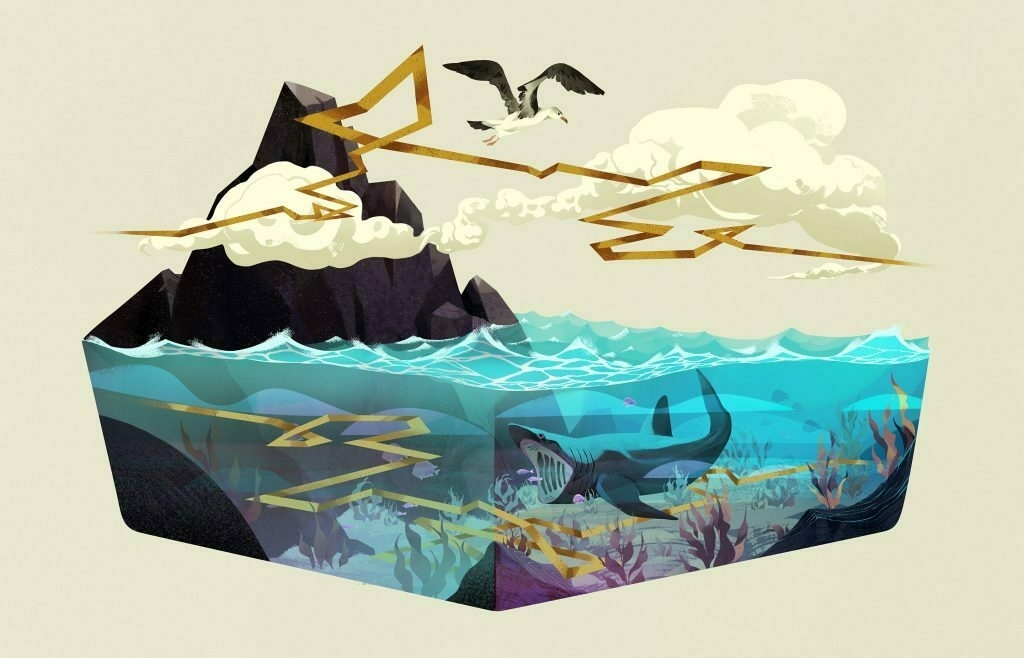
Random Search Wired Into Animals May Help Them Hunt
Lévy walks are now seen as a movement pattern that a nervous system can produce in the absence of useful sensory or mnemonic information, when it is an animal’s most advantageous search strategy. Of course, many animals may never employ a Lévy walk: If a polar bear can smell a seal, or a cheetah can see a gazelle, the animals are unlikely to engage in a random search strategy. “We expect the adaptation for Lévy walks to have appeared only where they confer practical advantages,” Viswanathan said.
Liam Drew (QUanta Magazine)
If you've watched wildlife documentaries, you probably know about Lévy walks (or 'flights'). This longish article gives a fascinating insight into the origin of the theory and how it can be useful in protecting different species.
A plan to turn the atmosphere into one, enormous sensor
One of AtmoSense’s first goals will be to locate and study phenomena at or close to Earth’s surface—storms, earthquakes, volcanic eruptions, mining operations and “mountain waves”, which are winds associated with mountain ranges. The aim is to see if atmospheric sensing can outperform existing methods: seismographs for earthquakes, Doppler weather radar for storms and so on.
The Economist
This sounds potentially game-changing. I can see the positives, but I wonder what the negatives will be?
Paths of desire: lockdown has lent a new twist to the trails we leave behind
Desire paths aren’t anything new – the term has been traced back to the French philosopher Gaston Bachelard, who wrote of “lignes de désir” in his 1958 book The Poetics of Space. Nature author Robert Macfarlane has written more recently about the inherent poetry of the paths. In his 2012 book The Old Ways: A Journey on Foot, Macfarlane calls them “elective easements” and says: “Paths are human; they are traces of our relationships.” Desire paths have been created by enthusiastic dogs in back gardens, by superstitious humans avoiding scaffolding and by students seeking shortcuts to class. Yet while illicit trails may have marked the easier (ie shorter) route for centuries, the pandemic has turned them into physical markers of our distance. Desire paths are no longer about making life easier for ourselves, but about preserving life for everyone.
Amelia Tait (The Guardian)
I've used desire paths as a metaphor many times in presentations and workshops over the last decade. This is an article that specifically talks about how they've sprung up during the pandemic.
Header image by Hans Braxmeier



